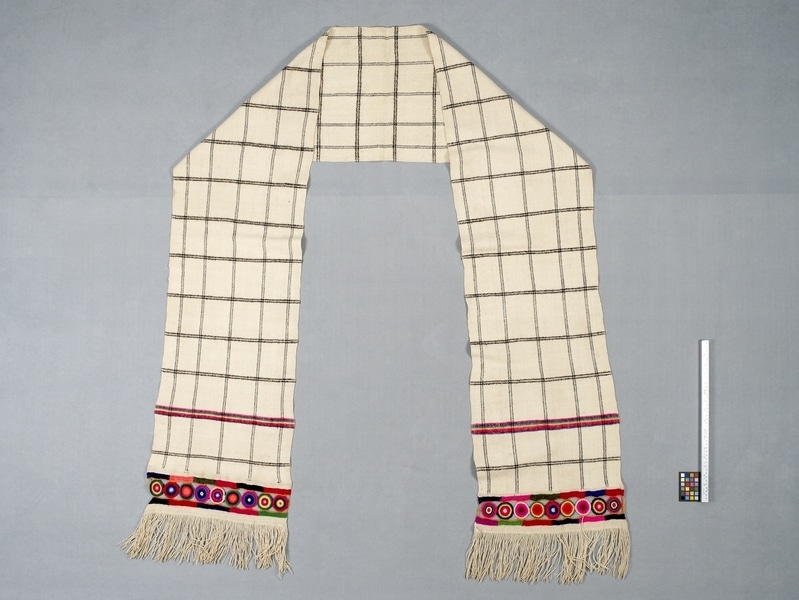Shawl Item Number: Sf966 from the MOA: University of British Columbia


Description
Shawl composed of off-white wool with a widely spaced black check with a band of woven multicoloured stripes near each end. Finished with a row of multicoloured crocheted circles and bands with an off-white fringe at each end.
History Of Use
Bayeta is made by males on the treadle loom and is used for garments that are cut to size and sewn, such as trousers, shirts, skirts and vests. The style, the construction and and the loom used are non-indigenous and derive from Spanish peasant tradition. Handspun sheep's wool is the traditional material, but synthetic yarns are now used. The shawl has been added to the men's costume since 1925. It can be worn folded in 4 and hanging over one shoulder; or worn folded across both shoulders so that both ends drape down the back; or folded and wound around the waist instead of or on top of the belt and underbelt.
Cultural Context
Everyday; men.
Narrative
Made by Francisco Yucra Cruz in about 1972 from yarn his wife spun. Bought by his son, Gonzalo Yucra Huatta, in about 1977 because it was a particularly nice shawl. Sold by Gonzalo to the Museum.
Specific Techniques
The white and blue yarns are z twist sheep's wool yarns. The colours are commercial, synthetic yarns, z spun and s plied. The fabric is a weft predominant 2/2 twill and the crochet additions are single and double stitches.
Item History
- Made by Francisco Yucra Cruz (Maker) in Taquile, Puno, Peru during 1972
- Collected during 1982
- Owned by Gonzalo Yucra Huatta
- Owned by Mary Frame before February 10, 1983
- Received from Mary Frame (Seller) and Museum of Anthropology Shop Volunteers (Funding source) on February 10, 1983
What
- Name
- Shawl
- Identification Number
- Sf966
- Type of Item
- shawl
- Material
- wool fibre and synthetic fibre
- Manufacturing Technique
- woven, spun and crocheted
- Overall
- height 352.0 cm, width 41.7 cm
Who
- Culture
- Quechua
- Creator
- Francisco Yucra Cruz (Maker)
- Previous Owner
- Gonzalo Yucra Huatta and Mary Frame
- Received from
- Mary Frame (Seller) and Museum of Anthropology Shop Volunteers (Funding source)
Where
- Holding Institution
- MOA: University of British Columbia
- Made in
- Taquile, Puno, Peru
When
- Creation Date
- during 1972
- Collection Date
- during 1982
- Ownership Date
- before February 10, 1983
- Acquisition Date
- on February 10, 1983
Other
- Item Classes
- textiles
- Condition
- good
- Accession Number
- 0861/0010